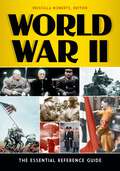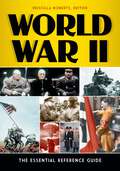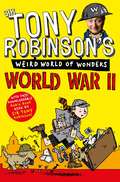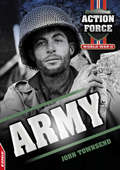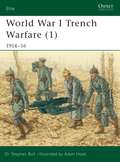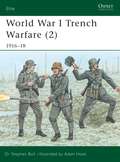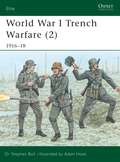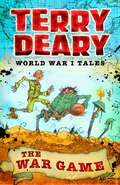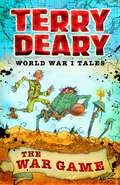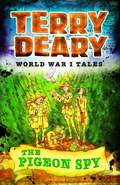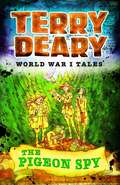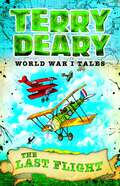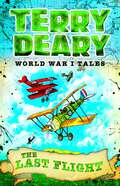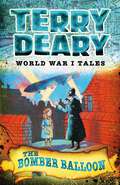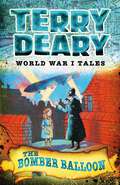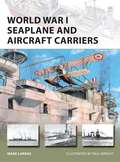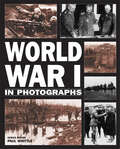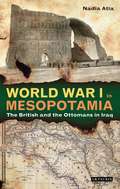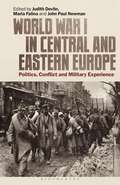- Table View
- List View
World War II: The Essential Reference Guide
by Priscilla RobertsIn this book an internationally renowned team of historians provides comprehensive coverage of all major campaigns and theaters of World War II, synthesizing the tremendous breadth and depth of source materials on this global conflict. It includes primary-source documents created by both famous leaders and average citizens.World War II: The Essential Reference Guide provides a comprehensive overview of the major events, campaigns, battles, personalities, and issues of World War II, supplemented by a selection of primary-source documents. Comprising essays written by leading international scholars that introduce non-specialist readers to all the major theaters of the war, this volume covers the entire span—both geographically and chronologically—of this far-reaching conflict.A selection of official and personal documents conveys the emotionally charged tenor of the period and the tremendous psychological impact of the war on those involved in it, both directly and indirectly. The book includes scholarly essays on enduring dilemmas of World War II, such as whether the United States justified in dropping the atomic bomb on Japan, as well as comprehensive essays on the causes, course, and consequences of the war.
World War II: The Essential Reference Guide
by Priscilla RobertsIn this book an internationally renowned team of historians provides comprehensive coverage of all major campaigns and theaters of World War II, synthesizing the tremendous breadth and depth of source materials on this global conflict. It includes primary-source documents created by both famous leaders and average citizens.World War II: The Essential Reference Guide provides a comprehensive overview of the major events, campaigns, battles, personalities, and issues of World War II, supplemented by a selection of primary-source documents. Comprising essays written by leading international scholars that introduce non-specialist readers to all the major theaters of the war, this volume covers the entire span—both geographically and chronologically—of this far-reaching conflict.A selection of official and personal documents conveys the emotionally charged tenor of the period and the tremendous psychological impact of the war on those involved in it, both directly and indirectly. The book includes scholarly essays on enduring dilemmas of World War II, such as whether the United States justified in dropping the atomic bomb on Japan, as well as comprehensive essays on the causes, course, and consequences of the war.
World War II: World War I And World War Ii (Sir Tony Robinson's Weird World of Wonders #2)
by Sir Tony RobinsonWinner of Best Books with Facts in the 2013 Blue Peter awards, voted for by children.In Sir Tony Robinson's Weird World of Wonders World War II, Sir Tony Robinson takes you on a headlong gallop through time, pointing out all the most important, funny, strange, amazing, entertaining, smelly and disgusting bits about World War II! It's history, but not as we know it!Find out everything you need to know in this brilliant, action-packed, fact-filled book, including:- Just how useful mashed potato is- How the Battle of Britain was won- What it takes to be a spy- How D-Day was kept a surpriseFor more World War history facts in this fun series, discover World War I.
World War II: Army (PDF) (EDGE: Action Force #5)
by John TownsendInside Army: The armies of World War II - Jungle battles - Panzer attack - Infantry weapons - Dunkirk - Artillery weapons - D-Day - North Africa, plus much more!Get tough with some of World War II's fighting men and units. From battlefield frontlines to navalconvoys, from secret missions to aerial dogfights, Action Force brings together the people,weapons, vehicles, the stats and the facts in oneall-action World War II series. You want action packed? Read Action Force!
World War II: A Military History (History Press Ser.)
by Alan WarrenIn the First World War many battles on the Western Front had lasted weeks or months. All too often they degenerated into glacial and indecisive campaigns of attrition. By the 1930s, however, military science had recreated the possibility of a decisive battle. An unprecedented rate of technological change meant that a stream of new inventions were readily at hand for military innovators to exploit. Aircraft, armoured vehicles and new forms of motorised transport became available to make possible a fresh style of offensive warfare when the next European war began in 1939. A belief in the importance of effective war fighting was vital to the Nazi vision of Germany's future. Nazi Germany's political and military leaders aimed for rapid and decisive victory in battle. From 1939-45 new ideologies and new machines of war carried destruction across the globe. Alan Warren chronicles the sixteen most decisive battles of the Second World War, from the Blitzkrieg of Poland to the fall of Berlin.
World War I Trench Warfare: 1914–16 (Elite)
by Stephen BullThe regular armies which marched off to war in 1914 were composed of massed riflemen, screened by cavalry and supported by artillery; their leaders expected a quick and decisive outcome, achieved by sweeping manoeuvre, bold leadership and skill at arms. Eighteen months later the whole nature of field armies and their tactics had changed utterly. In sophisticated trench systems forming a battlefield a few miles wide and 400 miles long, conscript armies sheltered from massive long-range bombardment, wielding new weapons according to new tactical doctrines. This first of two richly illustrated studies explains in detail the specifics of that extraordinary transformation, complete with ten full colour plates of uniforms and equipment.
World War I Trench Warfare: 1916–18 (Elite)
by Stephen BullThe Allied attempt to break the stalemate of trench warfare by the 'big pushes' of 1916 led to massively costly battles of attrition. The Germans responded by developing schemes of defence in depth anchored on concrete bunkers; the Allies, by sophisticated artillery tactics in support of infantry assaults, and by the introduction of the tank - at first an accident-prone novelty, but later a front-breaking weapon. On both sides the small, self-reliant, opportunistic infantry unit, with its own specialist weapons, became the basic tool of attack. This second of a fascinating two-part study of the birth of 20th century tactics is illustrated in colour and includes rare photographs.
World War I Trench Warfare: 1914–16 (Elite)
by Stephen BullThe regular armies which marched off to war in 1914 were composed of massed riflemen, screened by cavalry and supported by artillery; their leaders expected a quick and decisive outcome, achieved by sweeping manoeuvre, bold leadership and skill at arms. Eighteen months later the whole nature of field armies and their tactics had changed utterly. In sophisticated trench systems forming a battlefield a few miles wide and 400 miles long, conscript armies sheltered from massive long-range bombardment, wielding new weapons according to new tactical doctrines. This first of two richly illustrated studies explains in detail the specifics of that extraordinary transformation, complete with ten full colour plates of uniforms and equipment.
World War I Trench Warfare: 1916–18 (Elite)
by Stephen BullThe Allied attempt to break the stalemate of trench warfare by the 'big pushes' of 1916 led to massively costly battles of attrition. The Germans responded by developing schemes of defence in depth anchored on concrete bunkers; the Allies, by sophisticated artillery tactics in support of infantry assaults, and by the introduction of the tank - at first an accident-prone novelty, but later a front-breaking weapon. On both sides the small, self-reliant, opportunistic infantry unit, with its own specialist weapons, became the basic tool of attack. This second of a fascinating two-part study of the birth of 20th century tactics is illustrated in colour and includes rare photographs.
World War I Tales: The War Game (Terry Deary's Historical Tales)
by Terry DearyFrom the bestselling author of Horrible Histories...Stories of the First World War from the bestselling Terry Deary, author of the hugely successful Horrible Histories. Flanders, 1914. The German and British soldiers in the trenches make an unofficial Christmas truce, with carols and a football match. But the officers aren't happy...A veteran soldier and a young recruit are 'celebrating' Christmas in the trenches of Flanders in 1914. They hear the enemy sing carols and watch them place Christmas Trees in the trenches opposite. They begin to shout greetings across no-man's land and end up playing an international football match. The match is hard-fought but with moments of generosity and sportsmanship on both sides. They see the 'enemy' as vulnerable humans and the officers are furious. Further unofficial truces are banned and the war goes on with bullets instead of footballs. But it's a memory that stays with young Albert long after the war. A moving and fascinating look at a very human moment of the Great War, by the master historical storyteller.Book Band: GreyIdeal for ages 8+Quizzed for Accelerated Reader
World War I Tales: The War Game (Terry Deary's Historical Tales)
by Terry DearyFrom the bestselling author of Horrible Histories...Stories of the First World War from the bestselling Terry Deary, author of the hugely successful Horrible Histories. Flanders, 1914. The German and British soldiers in the trenches make an unofficial Christmas truce, with carols and a football match. But the officers aren't happy...A veteran soldier and a young recruit are 'celebrating' Christmas in the trenches of Flanders in 1914. They hear the enemy sing carols and watch them place Christmas Trees in the trenches opposite. They begin to shout greetings across no-man's land and end up playing an international football match. The match is hard-fought but with moments of generosity and sportsmanship on both sides. They see the 'enemy' as vulnerable humans and the officers are furious. Further unofficial truces are banned and the war goes on with bullets instead of footballs. But it's a memory that stays with young Albert long after the war. A moving and fascinating look at a very human moment of the Great War, by the master historical storyteller.Book Band: GreyIdeal for ages 8+Quizzed for Accelerated Reader
World War I Tales: The Pigeon Spy (Terry Deary's Historical Tales)
by Terry DearyFrom the bestselling author of Horrible Histories...Stories of the First World War from the bestselling Terry Deary, author of the hugely successful Horrible Histories. Flanders 1918. The extraordinary true story of a pigeon who saved nearly 200 lives. A troop of Americans are trapped behind enemy lines. Not only are their German enemies firing at them but so are their own side. Somehow they have to get a message to their comrades. The only way is by pigeon. But every time a pigeon rises in the air it is shot down. The last pigeon, a black bird called Cher Ami, flies with bullets zipping through the air all around him, covering 25 miles in just 65 minutes, helping to save the lives of the 194 survivors. In his epic journey he is shot through the breast, blinded in one eye, and left with a leg hanging only by a tendon. Army medics save his life. They can't save his leg, so they carve a small wooden one for him. When he recovers, the pigeon is put on a boat to the United States, a hero. Astonishing true tale of animals at war from master historical storyteller Terry Deary.Book Band: GreyIdeal for ages 8+Quizzed for Accelerated Reader
World War I Tales: The Pigeon Spy (Terry Deary's Historical Tales)
by Terry DearyFrom the bestselling author of Horrible Histories...Stories of the First World War from the bestselling Terry Deary, author of the hugely successful Horrible Histories. Flanders 1918. The extraordinary true story of a pigeon who saved nearly 200 lives. A troop of Americans are trapped behind enemy lines. Not only are their German enemies firing at them but so are their own side. Somehow they have to get a message to their comrades. The only way is by pigeon. But every time a pigeon rises in the air it is shot down. The last pigeon, a black bird called Cher Ami, flies with bullets zipping through the air all around him, covering 25 miles in just 65 minutes, helping to save the lives of the 194 survivors. In his epic journey he is shot through the breast, blinded in one eye, and left with a leg hanging only by a tendon. Army medics save his life. They can't save his leg, so they carve a small wooden one for him. When he recovers, the pigeon is put on a boat to the United States, a hero. Astonishing true tale of animals at war from master historical storyteller Terry Deary.Book Band: GreyIdeal for ages 8+Quizzed for Accelerated Reader
World War I Tales: The Last Flight (Terry Deary's Historical Tales)
by Terry DearyFrom the bestselling author of Horrible Histories...Stories of the First World War from the bestselling Terry Deary, author of the hugely successful Horrible Histories. France 1917 - the war in the air. An air observer is shot down behind enemy lines and meets the German flying ace, the famous Red Baron.Photographer Alfred Adams was born 1 June 1896 and became an observer in WW1, taking pictures over enemy lines. He was shot down by the famous 'Red Baron' Manfred von Richthofen over France along with his pilot Donald Stewart on 5 April 1917. They landed across enemy lines and both survived as prisoners of war. The tale tells how Alfred ended up spending his 21st birthday in a German prisoner of war camp, where he was visited by the Red Baron himself. The master historical storyteller gives readers a fascinating look at the First World War in the air, from both sides.Book Band: GreyIdeal for ages 8+Quizzed for Accelerated Reader
World War I Tales: The Last Flight (Terry Deary's Historical Tales)
by Terry DearyFrom the bestselling author of Horrible Histories...Stories of the First World War from the bestselling Terry Deary, author of the hugely successful Horrible Histories. France 1917 - the war in the air. An air observer is shot down behind enemy lines and meets the German flying ace, the famous Red Baron.Photographer Alfred Adams was born 1 June 1896 and became an observer in WW1, taking pictures over enemy lines. He was shot down by the famous 'Red Baron' Manfred von Richthofen over France along with his pilot Donald Stewart on 5 April 1917. They landed across enemy lines and both survived as prisoners of war. The tale tells how Alfred ended up spending his 21st birthday in a German prisoner of war camp, where he was visited by the Red Baron himself. The master historical storyteller gives readers a fascinating look at the First World War in the air, from both sides.Book Band: GreyIdeal for ages 8+Quizzed for Accelerated Reader
World War I Tales: The Bomber Balloon (Terry Deary's Historical Tales)
by Terry DearyFrom the bestselling author of Horrible Histories...Stories of the First World War from the bestselling Terry Deary, author of the hugely successful Horrible Histories. November 1916 - the war on the Home Front. Millie is being told off for breaching the blackout when a Zeppelin airship crashes over Essex. Millie, the local constable and an elderly helper must round up the armed German crew before they escape. Meanwhile the 'invaders' are worrying about accidentally setting fire to the houses they were bombing! A strange but true tale of the Home Front for 7+ from the master historical storyteller.Book Band: GreyIdeal for ages 8+Quizzed for Accelerated Reader
World War I Tales: The Bomber Balloon (Terry Deary's Historical Tales)
by Terry DearyFrom the bestselling author of Horrible Histories...Stories of the First World War from the bestselling Terry Deary, author of the hugely successful Horrible Histories. November 1916 - the war on the Home Front. Millie is being told off for breaching the blackout when a Zeppelin airship crashes over Essex. Millie, the local constable and an elderly helper must round up the armed German crew before they escape. Meanwhile the 'invaders' are worrying about accidentally setting fire to the houses they were bombing! A strange but true tale of the Home Front for 7+ from the master historical storyteller.Book Band: GreyIdeal for ages 8+Quizzed for Accelerated Reader
World War I Seaplane and Aircraft Carriers (New Vanguard)
by Mark Lardas Mr Paul WrightIn 1910 the first aircraft was successfully launched from a small wooden platform on a stationary ship. Just four years later, seaplane-carrying warships were being used to launch the first naval air raids, and by 1918 the first aircraft carrier to feature a full-length flight deck was in service. High quality artwork and historical photographs help author Mark Lardas tell the fascinating story of the pioneering years of naval aviation, covering such historic clashes as the Japanese siege of Tsingtao, the British raid against German Zeppelin bases at Cuxhaven and the Battle of Jutland, which saw the first airplane take part in a naval battle. Through detailed analysis he explores their development from hastily adapted merchant ships to the launch of HMS Argus, the first aircraft carrier to have a full-length flight deck, and shows how they paved the way for the aircraft carriers of the future.
World War I Seaplane and Aircraft Carriers (New Vanguard)
by Paul Wright Mark LardasIn 1910 the first aircraft was successfully launched from a small wooden platform on a stationary ship. Just four years later, seaplane-carrying warships were being used to launch the first naval air raids, and by 1918 the first aircraft carrier to feature a full-length flight deck was in service. High quality artwork and historical photographs help author Mark Lardas tell the fascinating story of the pioneering years of naval aviation, covering such historic clashes as the Japanese siege of Tsingtao, the British raid against German Zeppelin bases at Cuxhaven and the Battle of Jutland, which saw the first airplane take part in a naval battle. Through detailed analysis he explores their development from hastily adapted merchant ships to the launch of HMS Argus, the first aircraft carrier to have a full-length flight deck, and shows how they paved the way for the aircraft carriers of the future.
World War I in Photographs
by Andrew WebbAn astonishing visual account of the "Great War", recounting the loss, the tragedy, the courage and the horror of military action in vivid detail. Over 200 original photographs chart the events of 1914-1918, from early mobile warfare through the grim slogging matches in the trenches to Germany's last desperate throw of the dice and eventual allied victory. This book encompasses war on the ground, in the air, at sea and on the home front.
World War I in Mesopotamia: The British and the Ottomans in Iraq (Library Of Middle East History Ser.)
by Nadia AtiaThe Punjab region of India sent more than 600,000 combatants to assist the British war effort during World War I. Their families back home, thousands of miles from the major scenes of battle, were desperate for war news, and newspapers provided daily reports to keep the local population up-to-date with developments on the Western Front. This book presents the first English-language translations of hundreds of articles published during World War I in the newsapers of the Punjab region. They offer a lens into the anxieties and aspirations of Punjabis, a population that committed resources, food, labour as well as combatants to the British war effort. Amidst a steadily growing field of studies on World War I that examine the effects of the war on colonial populations, War News in India makes a unique and timely contribution.
World War I in Central and Eastern Europe: Politics, Conflict and Military Experience (International Library Of Twentieth Century History Ser.)
by Judith Devlin Maria Falina John Paul NewmanIn the English language World War I has largely been analysed and understood through the lens of the Western Front. This book addresses this imbalance by examining the war in Eastern and Central Europe. The historiography of the war in the West has increasingly focused on the experience of ordinary soldiers and civilians, the relationships between them and the impact of war at the time and subsequently. This book takes up these themes and, engaging with the approaches and conclusions of historians of the Western front, examines wartime experiences and the memory of war in the East. Analysing soldiers' letters and diaries to discover the nature and impact of displacement and refugee status on memory, this volume offers a basis for comparison between experiences in these two areas. It also provides material for intra-regional comparisons that are still missing from the current research. Was the war in the East wholly 'other'? Were soldiers in this region as alienated as those in the West? Did they see themselves as citizens and was there continuity between their pre-war or civilian and military identities? And if, in the Eastern context, these identities were fundamentally challenged, was it the experience of war itself or its consequences (in the shape of imprisonment and displacement, and changing borders) that mattered most? How did soldiers and citizens in this region experience and react to the traumas and upheavals of war and with what consequences for the post-war era? In seeking to answer these questions and others, this volume significantly adds to our understanding of World War I as experienced in Central and Eastern Europe.
World War I Companion
by Gary Sheffield Matthias StrohnThe pieces in this book form an excellent introduction to the military history of World War I that will also prove valuable to specialists in the subject.' Professor Gary Sheffield World War I changed the face of the 20th century. For four long years the major European powers, later joined by America, fought in a life or death struggle that would topple the crowned heads of Europe and redraw the map of the Continent. It was a conflict unparalleled in its scale, which in turn fuelled devastatingly rapid developments in military technology, technique and innovation as the belligerent powers sought to break the deadlock on the Western Front and elsewhere. In the centenary of the outbreak of the conflict, 14 renowned historians from around the world examine some of the key aspects of the war, providing a wide-ranging analysis of the whole conflict beyond but including the stalemate in the trenches of the Western Front.
World War I Companion
by Professor Gary Sheffield Matthias StrohnThe pieces in this book form an excellent introduction to the military history of World War I that will also prove valuable to specialists in the subject.' Professor Gary Sheffield World War I changed the face of the 20th century. For four long years the major European powers, later joined by America, fought in a life or death struggle that would topple the crowned heads of Europe and redraw the map of the Continent. It was a conflict unparalleled in its scale, which in turn fuelled devastatingly rapid developments in military technology, technique and innovation as the belligerent powers sought to break the deadlock on the Western Front and elsewhere. In the centenary of the outbreak of the conflict, 14 renowned historians from around the world examine some of the key aspects of the war, providing a wide-ranging analysis of the whole conflict beyond but including the stalemate in the trenches of the Western Front.
World War I Battlefield Artillery Tactics (Elite)
by Peter Dennis Dale ClarkeAs the First World War bogged down across Europe resulting in the establishment of trench systems, artillery began to grow in military importance. Never before had the use of artillery been so vital, and to this day the ferocity, duration and widespread use of artillery across the trenches of Europe has never been replicated. Featuring specially commissioned full-colour artwork, this groundbreaking study explains and illustrates the enormous advances in the use of artillery that took place between 1914 and 1918, the central part artillery played in World War I and how it was used throughout the war, with particular emphasis on the Western Front.
